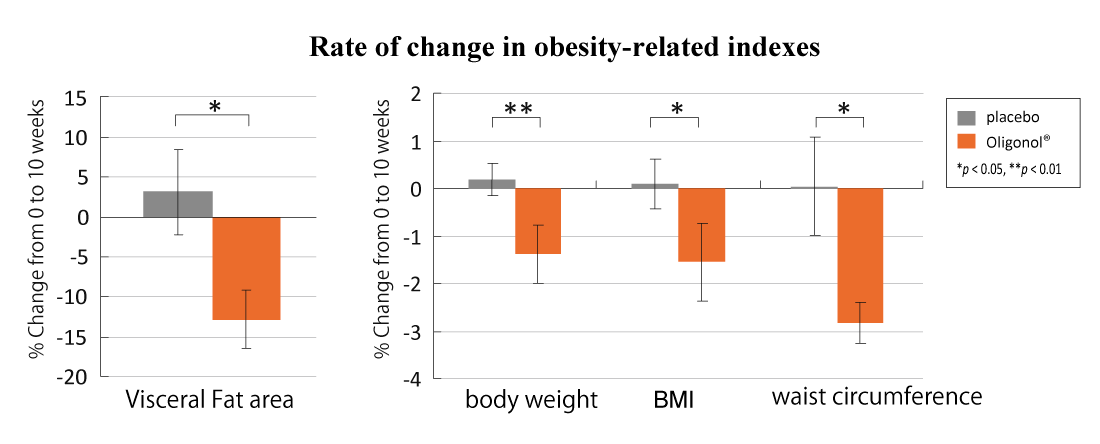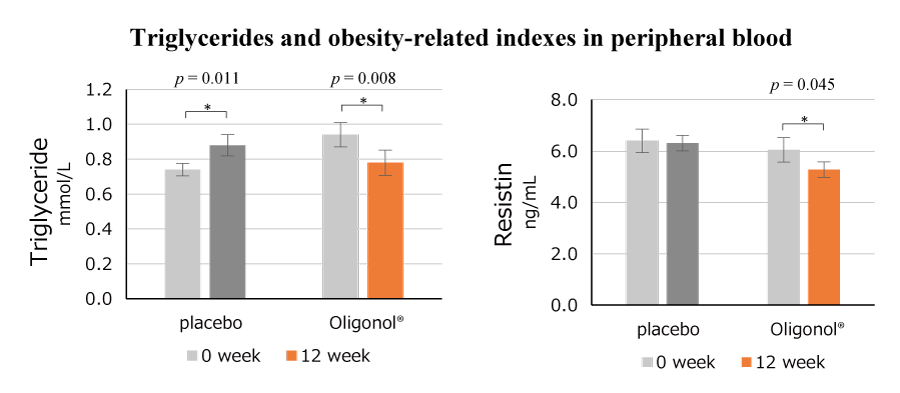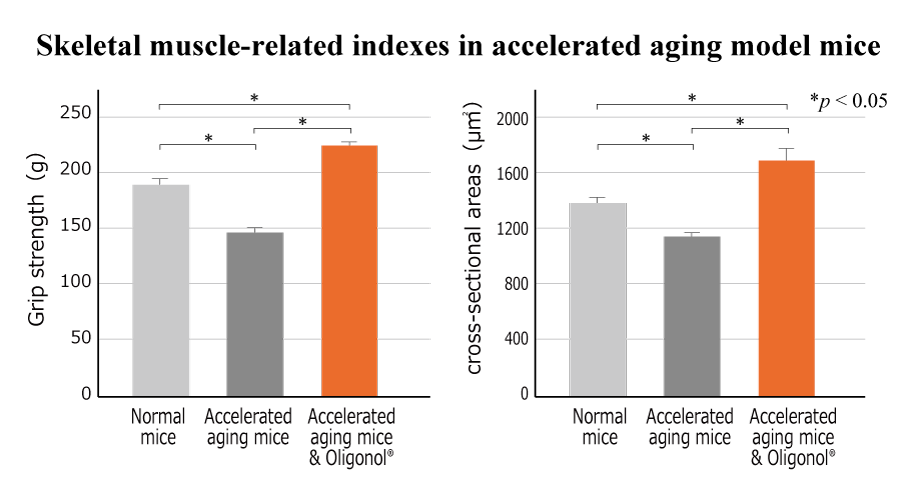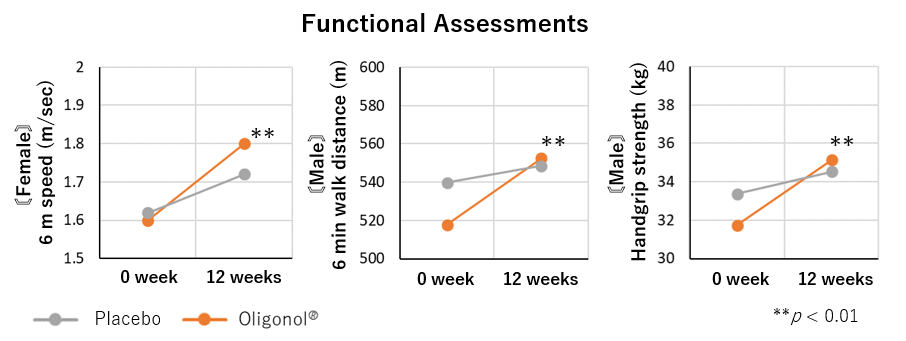Oligonol®Study Results
Metabolic Syndrome and Aging
RESEARCHVisceral fat reduction
Oligonol® reduced visceral fat, weight and waist circumference.
There is a phrase “metabolic domino” which figuratively describes an unpleasant sequence of lifestyle-related illnesses that starts from obesity and ends up to develop lethal diseases, like one domino falling after another. Metabolic syndrome is generally defined as a cluster of risk factors for such diseases, including high blood sugar, high blood pressure, unhealthy cholesterol levels, and extra abdominal fat.
In healthy adults with waist measurement over 85cm, 10-week supplementation with Oligonol® reduced the section area of visceral fat in CT scan graphical content, body weight, BMI, and abdominal circumference. Theses findings indicate that Oligonol® is possible to ameliorate metabolic syndrome.

Jun Nishihira et al., Journal of Functional Foods, 1(4): 341-348 (2009)
Clinical study
Design: A randomized, double-blind, placebo-controlled trial
Subject: 18 volunteers (24-59 years old) with abdominal circumference over 85 cm
Groups: Oligonol® (n=10) and placebo (n=8)
Dose and period: 200 mg/day for 10 weeks
Endpoints: Physical and hematological examinations and CT scan of the abdomen
Results
Oligonol® intake significantly decreased clinical parameters including body weight, BMI, abdominal circumference, and visceral fat volume. In addition, Oligonol® increased serum adiponectin and ameliorated insulin resistance, suggesting that Oligonol® might improve metabolic syndrome by reducing visceral fat obesity.
Data are expressed as means±standard error of the mean (SEM).
RESEARCHBlood lipid improvement
Oligonol® reduced diabetes risks by decreasing neutral fat in the blood.
Lifestyle-related illness caused by obesity is one of the global health problems. In particular, type 2 diabetes mellitus induces complicating disorders such as retinopathy, neurological failure, nephropathy, heart disease, and brain stroke, sometimes resulting in a life-threatening condition.
This study reveals if Oligonol® remedies obesity-related symptoms.
When overweight and/or obese females consumed Oligonol® for 12 weeks, the results demonstrated that Oligonol® decreased triglycerides and resistin, a contributory factor of diabetes, and prohibited body weight gain.
Taken together, it was suggested that Oligonol® might prevent obesity-induced diseases including type 2 diabetes mellitus via weight control.

Suhad M. Bahijri et al.,Current Nutrition & Food Science, 14(2): 164-170 (2018)
Clinical study
Design: A double-blind/case-control trial
Subject: 60 overweight and obese female volunteers
Groups: Oligonol® (n=30) and placebo (n=30)
Dose and period: 200 mg/day for 12 weeks
Endpoints: Body measurements and hematological examinations including triglycerides and resistin
Results
In comparison between 22 Oligonol® and 25 placebo subjects who completed the study, Oligonol® significantly reduced means of serum triglycerides and resistin. Besides, although the placebo group showed significant elevations of body weight, waist and hip circumferences, and resistin, there were no elevations in the Oligonol® group. These data suggested that Oligonol® could be involved in hypolipidemic and weight controlling functions in overweight and obese females.
Data are presented as means±standard deviation (SD).
RESEARCHSarcopenia*1
Oligonol® prevented loss of muscle strength and mass.
Sarcopenia is defined as decreased physical function resulting from reduced muscle mass with advancing age, and frailty means fragile constitution attributable to mind and body decaying with increased age. Since sarcopenia and frailty are steps prior to nursing care requirement, they are critical issues to be addressed in order to expand a healthy life-span.
The results from this study showed that administration of Oligonol® to senescence-accelerated mice (SAM) with fast aging rate increased the of mustle mass and grip strength, suggesting that Oligonol® could help to maintain a long healthy life.

Yun-Ching Chang et al., Molecular Nutrition & Food Research, 63(10): e1801102 (2019)
Non-clinical study (in vivo)
Animal: Senescence-accelerated mouse resistant (SAMR1) and senescence-accelerated mouse prone 8 (SAMP8) mice
Groups: SAMR1 (n=10), SAMP8 (n=12), and Oligonol®/SAMP8 (n=12)
Dose and period: Oligonol® 200 mg/kg/day for 8 weeks
Evaluation: Skeletal muscle mass and muscular strength
Results
Oligonol® significantly increased skeletal muscle mass and cross-sectional areas and grip strength. It was suggested that Oligonol® might contribute to positive protein turnover and mitochondrial quality.
Data are shown as means±standard error of the mean (SEM).
Oligonol® improved physical performance in middle-aged and older adults.
People may lose up to 40% of skeletal muscle mass age 20 to 70 being reduced at an accelerated ratewith age. The result of this study in middle-aged and older adults showed that Oligonol® intake improved walking speed, andimproved walking distance and handgrip strength especially in males. Based on this result, Oligonol® could be beneficial in the prevention of age-related muscle loss.

Yun-Ching Chang et al., Molecular Nutrition & Food Research, 63(10): e1801102 (2019)
Non-clinical study (in vivo)
Design: A randomized, double-blind, placebo-controlled trial
Subject: 103 healthy males and females over 50 years old
Groups: Oligonol® (n=52) and placebo (n=51)
Dose and period: 200 mg/day for 12 weeks
Endpoints: Body composition and functional assessment
Results
Oligonol® significantly improved 6-meter walking speed. In males, Oligonol® significantly improved 6-minute walking distance and handgrip strength. In addition, although the males in the placebo group showed significant increases in the total body fat percentage and reductions in the midthigh muscle cross-sectional area, such significant fat increases or muscle loss were not seen in the males of the Oligonol® group. These data suggested that Oligonol® could maintain muscle mass and improve physical performance, especially in men.
*1 Sarcopenia
a syndrome characterized by progressive and generalized loss of skeletal muscle mass and strength. It is strictly correlated with physical disability and poor quality of life. Risk factors for sarcopenia include age, gender and level of physical activity. When left untreated, the risks to be in need of nursing care or bed-ridden becomes higher.